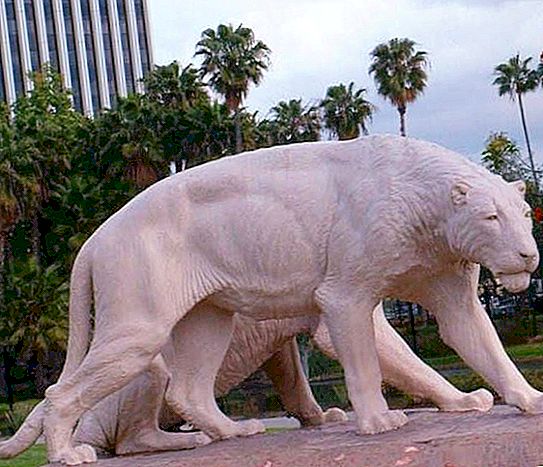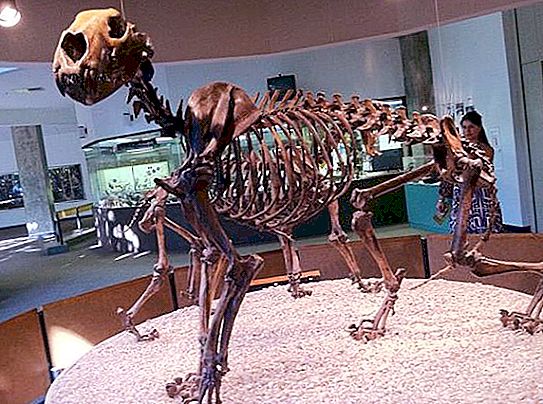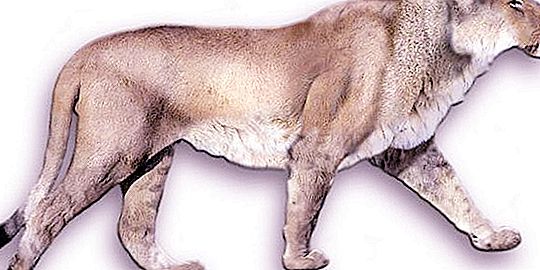For a long time, until the moment when a person became a hunter and acquired weapons, representatives of the cat family were at the top of the food chain of our planet. Of course, these were not modern lions, jaguars, leopards and tigers, but their extinct ancestors, such as the saber-toothed tiger or the American lion. We will get acquainted virtually with the prehistoric extinct American lion, or, as scientists call it, Panthera leo atrox.

Biological description
All lions, as well as jaguars, tigers and leopards are representatives of the cat family (Felidae), belong to the subfamily Pantherinae - large cats, and the genus Panthera (panther). According to scientific studies, the evolution of this species occurred about 900, 000 years ago where modern Africa is today. In the future, representatives of this species settled most of the territory of the Holarctic. The earliest remains of predators in Europe were found near the Italian city of Isernia, and their age was estimated at 700, 000 years. A cave lion inhabited the Eurasian continent about 300, 000 years ago. Thanks to the isthmus that connected America with Eurasia at that time, part of the population of these cave predators came through Alaska and Chukotka to North America, where due to prolonged isolation a new subspecies of lions, the American, was formed.
Related ties
As a result of a long joint work carried out by researchers from Russia, England, Australia and Germany, it was found that in total we had three species of lions on the planet. Today, in a fairly small area, a modern lion lives. But before him, there were two prehistoric and extinct species today. First of all, it is a cave lion (Panthera leo spelaea), which lived in western Canada and on the territory of almost the whole of Eurasia in the Pleistocene. In addition, there was also an American lion (Panthera leo atrox), who lived in the territory of the modern United States. And also in some areas of South America. It is also called the North American lion, or the giant jaguar Negele. As a result of research on the genetic material of fossil animals and modern predators, it was possible to establish that all three species of lions are very close in their genome. But here's what else scientists managed to find out: the subspecies of the American lion has been in genetic isolation for more than 340, 000 years, and during this time it began to be very different from other subspecies.
Where did they come from?
Initially, the lions that came from Africa settled on the territory of Eurasia and only then crossed the Beringia Isthmus, which connected North America with the Eurasian continent in those days, and began to explore a new continent. Scientists suggest that the emergence of two different species in North America is due to the isolation of representatives of these two populations as a result of glaciation. According to another hypothesis, various species: cave and American lions are representatives of two waves of migration from Eurasia, quite far removed from each other in time.
What did he look like?
Like other prehistoric predators, the American lion disappeared about 10, 000 years ago. At one time, he was one of the largest and most dangerous animals: its length could reach three meters and even more, and the weight reached up to 300 kg for females and 400 kg for males. There is still no agreement among scientists on the question of whether this animal had a mane, like its modern descendant, or not. However, they describe his appearance quite definitely: on powerful legs there was a dense, muscular body crowned with a large head, and behind was a long tail. The color of the skin, as the researchers suggest, was monophonic, but, perhaps, changed seasonally. Ligers are the most morphologically close to the American lion - the offspring of a tigress and a lion. It is difficult to imagine what the American lion looked like. Photos of the reconstruction of his appearance help to understand how much he looks like his modern "relative".
Where did you live?
As a result of archaeological excavations, the remains of this animal were discovered in a fairly large territory: from Peru to Alaska. This allowed scientists to argue that the American lion lived not only in the North, but also in certain regions of South America. Many of the remains of this animal were found near Los Angeles. Even today, despite the significant successes of science, scientists cannot name the exact and specific reasons that caused the disappearance of this predator about 10, 000 years ago. There are hypotheses about the depletion of forage land and the death of animals that served as food for American lions due to glaciation and changes in climatic conditions. There is also a version about the involvement of ancient people in the extermination of this formidable predator.
Food and competitors
The American lion at one time could hunt the ancestors of modern wapiti and bison, as well as the extinct shrubby bulls, western camels, wild bulls and horses (Equus). At the same time, other large predators, also extinct, lived on the North American continent.







